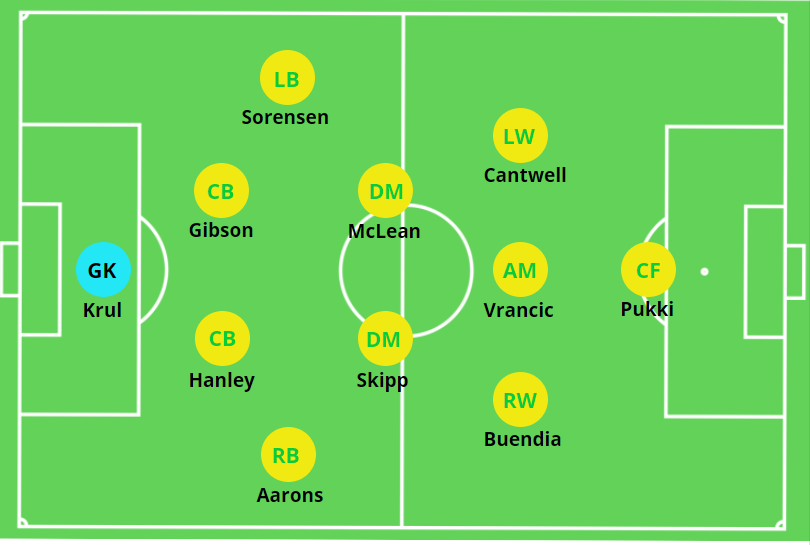While many Premier League teams of years past have succumbed to relegation and then sacked their manager, Norwich stuck by their man Daniel Farke, and it has paid off one season later. The German coach has inspired the Canaries to an instant return to England’s top flight, securing 97 points in their 46 EFL Championship fixtures. The last team to secure that many (or more) points was Wolverhampton Wanderers in 2017-18, and look at where they are now. So although the Canaries have been yo-yo-ing between the Championship and the Premier League in previous years, the club should have hope that their Premier League fortunes can change around next season. Here is a tactical analysis of Daniel Farke’s Norwich at the end of the 2020-21 Championship season.
system of play: 4-2-3-1

In many ways, Norwich are coached very similarly to some of Germany’s top sides. Daniel Farke’s principles of play are not only reliant on possession and width, but quick transitions, gegenpressing and simultaneous verticality. And not just that, but they also play in a 4-2-3-1 system, which to be fair is the most common formation in Europe’s top five leagues these days. But the Canaries stuck by their tried and tested formation more than most, playing all but one game this season utilizing the system of play.
Embed from Getty ImagesAlthough the entire squad deserves credit for their success, Emi Buendia is the undeniable star in the side. The Argentinean attacker assisted the most goals in the Championship this season, with 16 in 39 matches. But as if that wasn’t enough, he also chipped in with 15 goals, bringing his total goal contribution to 31 in 39. Norwich also still have Teemu Pukki, a man once claimed by this very site to be one of the top 100 players in the world. The Finnish striker netted 26 goals with 4 assists in 41 matches this season, finishing as the league’s third highest scorer. With Tim Krul in goal and Grant Hanley at centre-back, Norwich have two experienced Premier League players that not only eased their way through the season but could be key again in the top flight. In Max Aarons and Todd Cantwell, Norwich also have a youthful energy that emulate the club’s philosophy to promote young players from within. Oliver Skipp, Ben Gibson, Kenny McLean and Mario Vrancic all have Premier League experience too, and other Skipp have all been involved in a relegation battle before. The Canaries will do very well to keep hold of the on-loan Tottenham man, and having made 45 appearances this season will certainly need replacing should he return to North London.
Within this 4-2-3-1, the key is in direct, line-breaking play. Norwich do keep a lot of possession and play out from the back, but handing the ball over to Emi Buendia to work his magic is a must, and a strategy that has helped the Canaries to score 75 goals this season. So that’s the system and some of the players within, now let’s move onto exactly how Norwich have achieved so much success this season.
pressing
Embed from Getty ImagesNorwich press from the front, with much in the way of intention rather than just all out heavy metal running. The attacking midfielder will frequently push up alongside the striker in a 4-4-2 formation, but may also sit back in a more traditional 4-2-3-1 shape to track an opposition defensive midfielder. The fullbacks also push up quite high in the press, often past the central midfielders, providing additional cover in wide areas. Key to this approach is that the attackers are the first line of defense. Emi Buendia for example is actually one of the team’s greatest defensive assets, and has completed the most tackles of the entire team this season, 2.4 per game. It’s quite an astonishing number for an attacking midfielder, but it speaks to Norwich’s aggressive approach in quickly winning the ball after losing it. But aggression does not necessarily mean fouling and beating down one’s opponent. Norwich conceded the least amount of fouls per game this season, partially down to their high possession but also partially down to their careful approach to pressing.
Norwich also deploy a shape that is naturally suited to counter-pressing, how the team set up to win the ball back even though they’re the ones in possession. Their 2-4-4 attacking shape that sees the central midfielders and centre-backs engaged in a box like structure is quite solid. It means that wide areas that could theoretically be exposed on the break are usually able to be shut down, with central midfielders coming across and other players close by to recover and close the gaps.
Players are recruited into the club based on their ability to fulfill these philosophies, such as Oliver Skipp, who has a keen defensive awareness and succeeds in being an excellent tackler.
quick transitions
Embed from Getty ImagesAfter winning the ball, the Canaries place a large emphasis on quick transitions and verticality. Only Wycombe and Brentford utilized the centre of the pitch more for their attacks in 2020-21, with the Wanderers much more reliant on direct long passes into central channels, as opposed to utilizing verticality in transitional moments. Norwich on the other hand combine with short, quick passing moves, looking to get their danger men on the ball early on in moves. With several capable dribblers in the team, Norwich also succeed in using their pace and power on the dribble to advance past opposition defenses. This variety of dribbling, running power and precise passing makes them a particularly dangerous team, and aids in their ability to attack quickly.
The verticality also often comes after a pass out wide to start the move. In this sense, Buendia and Cantwell often hug the touchline, and are used as instant outlets after their team win the ball. They then play directly into the attacking midfielder or striker, as the opposite side winger drifts inside to cause further chaos. With a one-touch or minimal touch mentality, Norwich make themselves very difficult to stop in these moves. Further, with their attacking players operating in close proximity and allowing width to come from the fullbacks instead, they can often combine in tight areas to break the opposition down and create optimal scoring opportunities.
Teemu Pukki’s movement is also exceptional, which massively helps a team who want to attack quickly in this manner. The Finnish striker is adept at positioning himself in between two opposition defenders, causing a diffusion of responsibility to occur. He thrives off of balls over the top or through balls into his path, which Buendia and Cantwell are adept at providing. Both Norwich wingers also like to cut inside and operate in central channels, to which their long-range shooting makes Farke’s team even more difficult to stop.
BUILD UP
Embed from Getty ImagesDespite having that vertical, quick attacking transition mindset, Norwich also keep more possession than any other team in the Championship. Gibson and Hanley will often pass the ball around at the back, looking for the right openings, as Oliver Skipp drops to the side of them to pick up the ball. The fullbacks meanwhile generally remain higher, but may also come or even start deeper against a high press. However, usually Norwich are more patient in playing into the wide areas in their build-up, with the central players more involved and switches of play occurring higher up the field. Interestingly enough, Farke’s men have spent more time in their own third (31%) this season than the opposition’s third (27%). This is quite unusual for a team top of their domestic league, but speaks to their intentional build-up and overall patience, that is, when they see patience as the best approach to take.
Higher up the field, Farke’s team may form a 2-4-4 shape, with the fullbacks engaged high up the pitch. Max Aarons in particular holds a high position on the right, which compliments Emi Buendia’s constant desire to drift inside. The front four attackers will make varied runs in and around the middle of the pitch in this shape, picking up the ball, playing layoffs and then looking for switches of play. Even Pukki gets involved in this manner, frequently dropping deep to play with his back to goal and play a backwards pass, before the ball is switched out to the wing and the Finnish striker races in on goal to finish. As already discussed, this shape also aids in Norwich’s pressing, and their ability to counter-attack quickly.
concluding thoughts
Embed from Getty ImagesAfter sticking by Daniel Farke, Norwich have been rewarded, with the team accumulating the highest points total in the Championship since Nuno’s Wolves in 2018. Farke’s implemented a style that German footballing fans will be very familiar with, involving gegenpressing, counter-pressing, quick transitions and quick passing sequences. This style of play, the promotion of youth into the team, and their excellent recruitment have all combined to see Norwich finish first in the Championship this season, earning promotion into the Premier League. Whether or not they can stick around this time remains to be seen, but for now Norwich can celebrate, knowing they’ve done the job they set out to do at the start of the season.
So there it is! A tactical analysis of Norwich in 2020-21. Be sure to check out more of our Tactical Analyses, and follow on Twitter and Instagram @mastermindsite. Thanks for reading and see you soon!
You might also enjoy…
-> Marcelo Bielsa – Leeds United – Tactical Analysis (2020-21 Edition)
-> Marcelo Bielsa – Leeds United – Tactical Analysis (2019-20 Edition)
-> Nuno Espirito Santo – Wolves – Tactical Analysis (2019-20 Edition)


12 thoughts on “Daniel Farke – Norwich – Tactical Analysis”